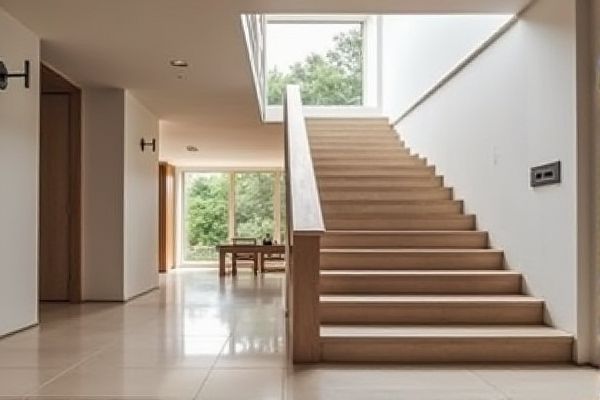
Minimalist stairs emphasize clean lines, open spaces, and simplicity, often using materials like glass and steel to create a light, airy feel contrasting the solid, ornate designs of traditional stairs made from wood or stone. Explore the rest of the article to discover which stair style complements your home's aesthetic and functional needs best.
Table of Comparison
| Feature | Minimalist Stairs | Traditional Stairs |
|---|---|---|
| Design | Simple, clean lines with open space | Ornate, detailed with closed risers |
| Material | Glass, metal, wood with sleek finishes | Wood, concrete, stone with classic finishes |
| Visual Impact | Light, airy, modern aesthetic | Heavy, solid, traditional appearance |
| Space Efficiency | Optimized for compact areas | Requires more space |
| Cost | Generally higher due to premium materials | Varies, often lower for basic designs |
| Maintenance | Easy to clean; minimal components | Depends on materials; may require repainting or refinishing |
| Safety | May require additional measures due to open risers | Typically safer with closed risers and handrails |
Understanding Minimalist Stairs
Minimalist stairs emphasize simplicity, clean lines, and functionality, often featuring open risers, slim profiles, and materials like glass, metal, or light wood to create a sense of space and light. Traditional stairs tend to have more elaborate designs, using solid wood, balusters, and decorative elements that add visual weight and classical appeal. Understanding minimalist stairs involves appreciating their role in modern architecture by enhancing openness while maintaining structural integrity and safety.
Defining Traditional Staircase Design
Traditional staircase design emphasizes ornate details, classic materials such as wood or wrought iron, and intricate balusters and newel posts that reflect historical architectural styles. These staircases often feature curved or turned elements, decorative moldings, and rich finishes that enhance a sense of elegance and craftsmanship. The design prioritizes visual complexity and historical authenticity, contrasting sharply with the clean lines and simplicity of minimalist stairs.
Visual Appeal: Minimalism vs Tradition
Minimalist stairs emphasize clean lines, open space, and simplicity, creating a sleek and modern visual appeal that enhances light flow and spatial perception. Traditional stairs often feature ornate details, rich materials, and classic craftsmanship, evoking a sense of warmth and historical character. The visual impact of minimalist stairs aligns with contemporary interior design trends, while traditional stairs contribute to a timeless and elegant ambiance.
Space Efficiency Comparison
Minimalist stairs maximize space efficiency by featuring sleek designs, open risers, and compact structures, allowing more usable floor area compared to traditional stairs with bulky supports and closed risers. Your living space benefits from the minimal footprint and enhanced light flow of minimalist stairs, ideal for smaller homes or modern interiors. Traditional staircases often require more installation space and can make rooms appear crowded due to their solid, heavy construction.
Material Selection and Durability
Minimalist stairs often utilize modern materials such as steel, glass, and engineered wood, providing sleek aesthetics combined with enhanced durability and resistance to wear. Traditional stairs typically rely on solid hardwoods and concrete, offering robustness but requiring more maintenance due to susceptibility to moisture and wear over time. The choice between these materials impacts longevity, maintenance needs, and overall structural integrity in stair design.
Safety Considerations in Both Styles
Minimalist stairs often feature open risers and sleek handrails, requiring careful attention to slip-resistant materials and secure balustrades to prevent falls. Traditional stairs typically have closed risers and more substantial handrails, which can enhance safety by providing solid support and reducing tripping hazards. Both styles must comply with building codes and safety standards, including tread depth, riser height, and handrail placement to ensure user security.
Cost and Installation Differences
Minimalist stairs typically feature streamlined designs using materials like steel, glass, or wood, resulting in lower material costs but potentially higher labor expenses due to specialized installation techniques. Traditional stairs often involve more extensive craftsmanship using hardwoods or concrete, leading to higher material costs but more straightforward installation processes by standard carpentry methods. Budget considerations should weigh the minimalist stairs' modern aesthetic and potential installation complexity against the traditional stairs' durability and conventional construction ease.
Maintenance and Longevity
Minimalist stairs typically feature sleek materials like metal and glass, which require less frequent cleaning and resist wear, enhancing longevity compared to traditional wooden stairs that often need regular polishing and repairs due to scratches or moisture damage. The straightforward design of minimalist stairs reduces nooks and crevices where dust and dirt accumulate, making maintenance more efficient. You can expect your minimalist stairs to maintain their aesthetic appeal longer with lower upkeep costs than traditional staircases.
Suitability for Modern Living Spaces
Minimalist stairs, characterized by clean lines, open risers, and sleek materials like glass or metal, seamlessly complement modern living spaces by enhancing natural light and creating an airy, spacious atmosphere. Traditional stairs, often featuring ornate details, closed risers, and heavier materials like wood, suit classic or vintage interiors but may visually clutter contemporary environments. Choosing minimalist stairs increases the perception of space and aligns with the functional aesthetics of modern architecture.
Choosing the Right Staircase for Your Home
Minimalist stairs feature clean lines, open risers, and sleek materials like glass or metal to create an airy, modern aesthetic, while traditional stairs emphasize ornate details, wood craftsmanship, and closed risers for a classic, timeless look. Your choice depends on the architectural style of your home, available space, and the desired impact on interior design, with minimalist stairs often enhancing smaller spaces by maximizing light and openness. Prioritize functionality, safety, and integration with your overall decor to select the staircase that best suits your lifestyle and enhances your home's value.
 homyna.com
homyna.com